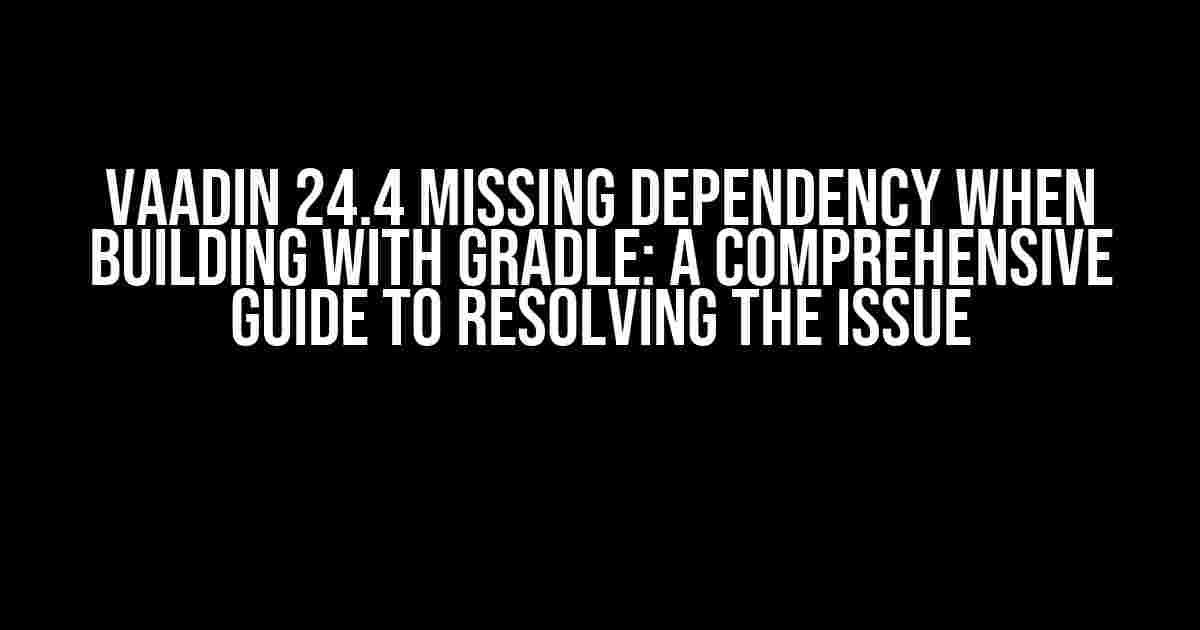Vaadin, a popular Java-based web framework, has been a favorite among developers for building modern web applications. However, with the release of Vaadin 24.4, many developers have been facing an frustrating issue – a missing dependency when building their projects with Gradle. In this article, we’ll delve into the root cause of the problem, and provide a step-by-step guide to resolving it.
What is the Missing Dependency Error?
The error message typically reads:
> Task :compileJava FAILED
org.gradle.api.tasks(TaskExecutionException) : Execution failed for task ':compileJava'.
> java.lang.NoClassDefFoundError: com/vaadin/flow/ annotations/Route
at com.example.MyUI. (MyUI.java:10)
...
Caused by: java.lang.ClassNotFoundException: com.vaadin.flow.annotations.Route
... 5 more
This error occurs when Gradle is unable to find the `com.vaadin.flow.annotations.Route` class, which is a part of the Vaadin framework. The reason behind this is due to a change in the Vaadin 24.4 release, which we’ll explore in the next section.
The Reason Behind the Missing Dependency
In Vaadin 24.4, the `vaadin-bom` (Bill of Materials) was introduced, which is a new way of managing dependencies in Vaadin projects. The `vaadin-bom` replaces the traditional `vaadin-core` dependency, and it’s designed to simplify dependency management. However, this change has caused confusion among developers, leading to the missing dependency error.
Resolving the Missing Dependency Error
Fortunately, resolving the missing dependency error is relatively straightforward. Here are the steps to follow:
Step 1: Update Your build.gradle File
The first step is to update your `build.gradle` file to include the `vaadin-bom` dependency. Add the following code to your `build.gradle` file:
<dependencies>
implementation platform('com.vaadin:vaadin-bom:24.4.0')
implementation 'com.vaadin.vaadin'
...
</dependencies>
This code tells Gradle to use the `vaadin-bom` dependency, which will automatically manage the Vaadin dependencies for you.
Step 2: Remove the vaadin-core Dependency
The next step is to remove the `vaadin-core` dependency from your `build.gradle` file. This is because the `vaadin-bom` dependency replaces the `vaadin-core` dependency.
<dependencies>
// Remove this line
// implementation 'com.vaadin:vaadin-core:24.4.0'
implementation platform('com.vaadin:vaadin-bom:24.4.0')
implementation 'com.vaadin.vaadin'
...
</dependencies>
Step 3: Update Your Project Structure
Vaadin 24.4 introduces a new project structure, which includes a `generated` folder. This folder contains the generated Vaadin classes. To update your project structure, follow these steps:
- Create a new folder named `generated` in your project’s root directory.
- Move the `com.vaadin.flow.annotations.Route` class (and any other generated classes) to the `generated` folder.
- Update your `build.gradle` file to include the `generated` folder in the source set:
<sourceSets>
main {
java {
srcDir 'src/main/java'
srcDir 'generated' // Add this line
}
}
</sourceSets>
This tells Gradle to include the `generated` folder in the source set, which will allow it to find the `com.vaadin.flow.annotations.Route` class.
Step 4: Rebuild Your Project
The final step is to rebuild your project using Gradle. Run the following command:
gradle build
This will rebuild your project, and the missing dependency error should be resolved.
Troubleshooting Common Issues
In this section, we’ll cover some common issues that you might encounter when resolving the missing dependency error:
Issue 1: Gradle Version Compatibility
If you’re using an older version of Gradle, you might encounter compatibility issues with Vaadin 24.4. To resolve this, make sure you’re using the latest version of Gradle (at least 7.1.1). You can update your Gradle version by running the following command:
gradle wrapper --gradle-version 7.1.1
Issue 2: Duplicate Class Definitions
If you have duplicate class definitions in your project, you might encounter issues with the `generated` folder. To resolve this, make sure you’ve removed any duplicate class definitions from your project.
Issue 3: Incorrect Project Structure
If your project structure is not correctly configured, you might encounter issues with the `generated` folder. Make sure you’ve followed the correct project structure outlined in Step 3.
Conclusion
The missing dependency error in Vaadin 24.4 can be frustrating, but by following the steps outlined in this article, you should be able to resolve the issue. Remember to update your `build.gradle` file, remove the `vaadin-core` dependency, update your project structure, and rebuild your project using Gradle. If you encounter any issues, refer to the troubleshooting section for common solutions.
With Vaadin 24.4, you can build modern web applications with ease. Don’t let the missing dependency error hold you back – follow this guide, and you’ll be back to building amazing applications in no time!
| Keyword | Description |
|---|---|
| Vaadin 24.4 | The latest version of the Vaadin framework, which introduces the vaadin-bom dependency |
| vaadin-bom | A Bill of Materials dependency that manages Vaadin dependencies |
| vaadin-core | A deprecated dependency that has been replaced by vaadin-bom |
| Gradle | A build tool that manages dependencies and builds projects |
Frequently Asked Question
Are you stuck with the infamous “Vaadin 24.4 missing dependency” error when building with Gradle? Worry not, friend! We’ve got the solutions to your burning questions right here.
Q1: What’s causing the Vaadin 24.4 missing dependency issue?
The missing dependency issue is often due to Vaadin’s Maven repository being removed from the public Maven repo. This means you need to add the Vaadin repository to your Gradle build file to resolve the issue.
Q2: How do I add the Vaadin repository to my Gradle build file?
Easy peasy! Just add the following code to your `build.gradle` file: `repositories { maven { url ‘https://repo.vaadin.com/releases’ } }`. This will let Gradle know where to find the Vaadin dependencies.
Q3: What if I’m using Gradle 7.x or later?
For Gradle 7.x or later, you’ll need to use the `mavenCentral()` repository instead of `maven { url ‘https://repo.vaadin.com/releases’ }`. The correct code would be: `repositories { mavenCentral() }`.
Q4: Are there any other possible reasons for the missing dependency issue?
Yes! Another common cause is a corrupted Gradle cache. Try deleting the Gradle cache by running `./gradlew –stop` and then `./gradlew build –refresh-dependencies` to rebuild your project.
Q5: What if I’m still stuck after trying these solutions?
Don’t worry, friend! If you’re still experiencing issues, try checking the Vaadin documentation, searching online forums, or reaching out to the Vaadin community for further assistance. We’re here to help!

